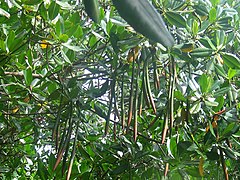Mangrove
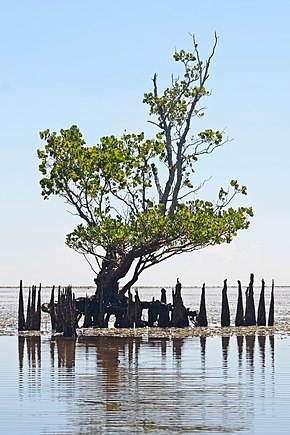
Amangroveis ashrubor tree that grows mainly in coastalsalineorbrackish water.Mangroves grow in an equatorial climate, typically along coastlines and tidal rivers. They have special adaptations to take in extra oxygen and to remove salt, which allow them to tolerate conditions that would kill most plants. The term is also used for tropical coastal vegetation consisting of such species. Mangroves are taxonomically diverse, as a result of convergent evolution in several plant families. They occur worldwide in thetropicsandsubtropicsand even sometemperatecoastal areas, mainly between latitudes 30° N and 30° S, with the greatest mangrove area within 5° of theequator.[1][2]Mangrove plant families first appeared during theLate CretaceoustoPaleoceneepochs, and became widely distributed in part due to themovement of tectonic plates.The oldest known fossils ofmangrove palmdate to 75 million years ago.[2]
Mangroves are salt-tolerant trees, shrubs and ferns also calledhalophytes,and are adapted to live in harsh coastal conditions. They contain a complex salt filtration system and a complex root system to cope with saltwater immersion and wave action. They are adapted to thelow-oxygenconditions of waterlogged mud,[3]but are most likely to thrive in the upper half of theintertidal zone.[4]
The mangrovebiome,often called themangrove forestor mangal, is a distinct salinewoodlandorshrublandhabitat characterized bydepositionalcoastal environments, where fine sediments (often with high organic content) collect in areas protected from high-energy wave action. Mangrove forests serve as vital habitats for a diverse array of aquatic species, offering a unique ecosystem that supports the intricate interplay of marine life and terrestrial vegetation. The saline conditions tolerated by various mangrove species range from brackish water, through pure seawater (3 to 4% salinity), to water concentrated by evaporation to over twice the salinity of ocean seawater (up to 9% salinity).[5][6]
Beginning in 2010,remote sensingtechnologies and global data have been used to assess areas, conditions anddeforestationrates of mangroves around the world.[7][1][2]In 2018, the Global Mangrove Watch Initiative released a new global baseline which estimates the total mangrove forest area of the world as of 2010 at 137,600 km2(53,100 sq mi), spanning 118 countries and territories.[2][7]A 2022 study on losses and gains of tidal wetlands estimates a 3,700 km2(1,400 sq mi) net decrease in global mangrove extent from 1999 to 2019.[8]Mangrove loss continues due to human activity, with a global annual deforestation rate estimated at 0.16%, and per-country rates as high as 0.70%. Degradation in quality of remaining mangroves is also an important concern.[2]
There is interest inmangrove restorationfor several reasons. Mangroves support sustainable coastal and marine ecosystems. They protect nearby areas fromtsunamisand extreme weather events. Mangrove forests are also effective atcarbon sequestrationand storage.[2][9][10]The success of mangrove restoration may depend heavily on engagement with local stakeholders, and on careful assessment to ensure that growing conditions will be suitable for the species chosen.[4]
TheInternational Day for the Conservation of the Mangrove Ecosystemis celebrated every year on 26 July.[11]
Etymology
[edit]
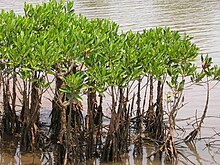
Etymology of the English termmangrovecan only be speculative and is disputed.[12]: 1–2 [13] The term may have come to English from the Portuguesemangueor the Spanish mangle.[13]Further back, it may be traced to South America andCaribanandArawakan languages[14]such asTaíno.[15]Other possibilities include theMalay languagemanggi-manggi[13][12] The English usage may reflect a corruption viafolk etymologyof the wordsmangrowandgrove.[14][12][16]
The word "mangrove" is used in at least three senses:
- Most broadly to refer to the habitat and entire plant assemblage ormangal,[13][17]for which the termsmangrove forestbiomeandmangrove swampare also used;
- To refer to all trees and large shrubs in a mangroveswamp;[13]and
- Narrowly to refer only to mangrove trees of the genusRhizophoraof thefamilyRhizophoraceae.[18]
Biology
[edit]According to Hogarth (2015), among the recognized mangrove species there are about 70 species in 20 genera from 16familiesthat constitute the "true mangroves" – species that occur almost exclusively in mangrove habitats.[17]Demonstratingconvergent evolution,many of these species found similar solutions to the tropical conditions of variable salinity, tidal range (inundation),anaerobicsoils, and intense sunlight. Plant biodiversity is generally low in a given mangrove.[19]The greatest biodiversity of mangroves occurs inSoutheast Asia,particularly in theIndonesian archipelago.[20]
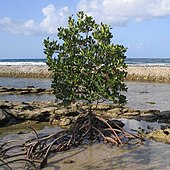
Adaptations to low oxygen
[edit]The red mangrove (Rhizophora mangle) survives in the most inundated areas, props itself above the water level with stilt or prop roots and then absorbs air throughlenticelsin its bark.[21] The black mangrove (Avicennia germinans) lives on higher ground and develops many specialized root-like structures calledpneumatophores,which stick up out of the soil like straws for breathing.[22][23] These "breathing tubes" typically reach heights of up to 30 cm (12 in), and in some species, over 3 m (9.8 ft). The roots also contain wideaerenchymato facilitate transport within the plants.[citation needed]
Nutrient uptake
[edit]Because the soil is perpetually waterlogged, little free oxygen is available.Anaerobic bacterialiberatenitrogengas, soluble ferrum (iron), inorganicphosphates,sulfides,andmethane,which make the soil much less nutritious.[citation needed]Pneumatophores (aerial roots) allow mangroves to absorb gases directly from the atmosphere, and other nutrients such as iron, from the inhospitable soil. Mangroves store gases directly inside the roots, processing them even when the roots are submerged during high tide.
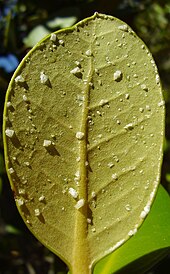
Limiting salt intake
[edit]Red mangroves exclude salt by having significantly impermeable roots that are highly suberised (impregnated withsuberin), acting as an ultrafiltration mechanism to excludesodiumsaltsfrom the rest of the plant.[citation needed]One study found that roots of the Indian mangroveAvicennia officinalisexclude 90% to 95% of the salt in water taken up by the plant, depositing the excluded salt in thecortexof the root. An increase in the production of suberin and in the activity of a gene regulatingcytochrome P450were observed in correlation with an increase in the salinity of the water to which the plant was exposed.[24]In a frequently cited concept that has become known as the "sacrificial leaf", salt which does accumulate in the shoot (sprout) then concentrates in old leaves, which the plant then sheds. However, recent research on the Red mangroveRhizophora manglesuggests that the older, yellowing leaves have no more measurable salt content than the other, greener leaves.[25]
-
Pneumatophorousaerial roots of the grey mangrove (Avicennia marina)
-
ViviparyinRhizophora mangleseeds
Limiting water loss
[edit]
Because of the limited fresh water available in salty intertidal soils, mangroves limit the amount of water they lose through their leaves. They can restrict the opening of theirstomata(pores on the leaf surfaces, which exchangecarbon dioxidegas and water vapor during photosynthesis). They also vary the orientation of their leaves to avoid the harsh midday sun and so reduce evaporation from the leaves. A captive red mangrove grows only if its leaves are misted with fresh water several times a week, simulating frequent tropical rainstorms.[27]
Filtration of seawater
[edit]A 2016 study by Kimet al.investigated the biophysical characteristics of sea water filtration in the roots of the mangroveRhizophora stylosafrom a plant hydrodynamic point of view.R. stylosacan grow even in saline water and the salt level in its roots is regulated within a certain threshold value through filtration. The root possesses a hierarchical, triple layered pore structure in theepidermisand most Na+ions are filtered at the first sublayer of the outermost layer. The high blockage of Na+ions is attributed to the high surfacezeta potentialof the first layer. The second layer, which is composed ofmacroporous structures,also facilitates Na+ion filtration. The study provides insights into the mechanism underlying water filtration throughhalophyteroots and could serve as a basis for the development of abio-inspiredmethod ofdesalination.[26]
Uptake of Na+ions is desirable for halophytes to build uposmotic potential,absorb water and sustainturgor pressure.However, excess Na+ions may work on toxic element. Therefore, halophytes try to adjust salinity delicately between growth and survival strategies. In this point of view, a novel sustainable desalination method can be derived from halophytes, which are in contact with saline water through their roots. Halophytes exclude salt through their roots, secrete the accumulated salt through their aerial parts and sequester salt insenescentleaves and/or the bark.[28][29][30]Mangroves are facultative halophytes andBruguierais known for its special ultrafiltration system that can filter approximately 90% of Na+ions from the surrounding seawater through the roots.[31][32][33]The species also exhibits a high rate of salt rejection. The water-filtering process in mangrove roots has received considerable attention for several decades.[34][35]Morphological structures of plants and their functions have been evolved through a long history to survive against harsh environmental conditions.[36][26]
Increasing survival of offspring
[edit]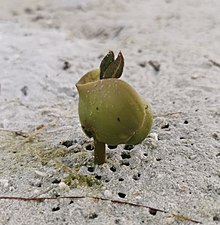
In this harsh environment, mangroves have evolved a special mechanism to help their offspring survive. Mangroveseedsare buoyant and are therefore suited to water dispersal. Unlike most plants, whose seeds germinate in soil, many mangroves (e.g.red mangrove) areviviparous,[37]meaning their seeds germinate while still attached to the parent tree. Once germinated, the seedling grows either within the fruit (e.g.Aegialitis,AvicenniaandAegiceras), or out through the fruit (e.g.Rhizophora,Ceriops,BruguieraandNypa) to form apropagule(a ready-to-go seedling) which can produce its own food viaphotosynthesis.
The mature propagule then drops into the water, which can transport it great distances. Propagules can survive desiccation and remain dormant for over a year before arriving in a suitable environment. Once a propagule is ready to root, its density changes so that the elongated shape now floats vertically rather than horizontally. In this position, it is more likely to lodge in the mud and root. If it does not root, it can alter its density and drift again in search of more favorable conditions.
Taxonomy and evolution
[edit]The following listings, based on Tomlinson, 2016, give the mangrove species in each listed plant genus and family.[38]Mangrove environments in the Eastern Hemisphere harbor six times as many species of trees and shrubs as do mangroves in the New World. Genetic divergence of mangrove lineages from terrestrial relatives, in combination with fossil evidence, suggests mangrove diversity is limited by evolutionary transition into the stressful marine environment, and the number of mangrove lineages has increased steadily over the Tertiary with little global extinction.[39]
True mangroves
[edit]| True mangroves (major components or strict mangroves) | ||||
|---|---|---|---|---|
| Following Tomlinson, 2016, the following 35 species are the true mangroves, contained in 5 families and 9 genera[38]: 29–30 Included on green backgrounds are annotations about the genera made by Tomlinson | ||||
| Family | Genus | Mangrove species | Common name | |
| Arecaceae | Monotypic subfamily within the family | |||
| Nypa | Nypa fruticans | Mangrove palm | 
| |
| Avicenniaceae (disputed) |
Old monogeneric family, now subsumed in Acanthaceae, but clearly isolated | |||
| Avicennia | Avicennia alba | 
| ||
| Avicennia balanophora | ||||
| Avicennia bicolor | ||||
| Avicennia integra | ||||
| Avicennia marina | grey mangrove (subspecies:australasica, eucalyptifolia,rumphiana) |
|||
| Avicennia officinalis | Indian mangrove | |||
| Avicennia germinans | black mangrove | |||
| Avicennia schaueriana | ||||
| Avicennia tonduzii | ||||
| Combretaceae | Tribe Lagunculariae (including Macropteranthes = non-mangrove) | |||
| Laguncularia | Laguncularia racemosa | white mangrove | 
| |
| Lumnitzera | Lumnitzera racemosa | white-flowered black mangrove | ||
| Lumnitzera littorea | ||||
| Rhizophoraceae | Rhizophoraceae collectively form the tribe Rhizophorae, a monotypic group, within the otherwise terrestrial family | |||
| Bruguiera | Bruguiera cylindrica | |||
| Bruguiera exaristata | rib-fruited mangrove | |||
| Bruguiera gymnorhiza | oriental mangrove | 
| ||
| Bruguiera hainesii | ||||
| Bruguiera parviflora | ||||
| Bruguiera sexangula | upriver orange mangrove | |||
| Ceriops | Ceriops australis | yellow mangrove | 
| |
| Ceriops tagal | spurred mangrove | 
| ||
| Kandelia | Kandelia candel | |||
| Kandelia obovata | ||||
| Rhizophora | Rhizophora apiculata | |||
| Rhizophora harrisonii | ||||
| Rhizophora mangle | red mangrove | |||
| Rhizophora mucronata | Asiatic mangrove | 
| ||
| Rhizophora racemosa | ||||
| Rhizophora samoensis | Samoan mangrove | |||
| Rhizophora stylosa | spotted mangrove, | |||
| Rhizophora x lamarckii | ||||
| Lythraceae | Sonneratia | Sonneratia alba | 
| |
| Sonneratia apetala | ||||
| Sonneratia caseolaris | ||||
| Sonneratia ovata | ||||
| Sonneratia griffithii | ||||
Minor components
[edit]| Minor components | ||||
|---|---|---|---|---|
| Tomlinson, 2016, lists about 19 species as minor mangrove components, contained in 10 families and 11 genera[38]: 29–30 Included on green backgrounds are annotations about the genera made by Tomlinson | ||||
| Family | Genus | Species | Common name | |
| Euphorbiaceae | This genus includes about 35 non-mangrove taxa | |||
| Excoecaria | Excoecaria agallocha | milky mangrove, blind-your-eye mangrove and river poison tree | 
| |
| Lythraceae | Genus distinct in the family | |||
| Pemphis | Pemphis acidula | bantigue or mentigi | ||
| Malvaceae | Formerly inBombacaceae,now an isolated genus in subfamily Bombacoideeae | |||
| Camptostemon | Camptostemon schultzii | kapok mangrove | 
| |
| Camptostemon philippinense | ||||
| Meliaceae | Genus of 3 species, one non-mangrove, forms tribe Xylocarpaeae with Carapa, a non–mangrove | |||
| Xylocarpus | Xylocarpus granatum | 
| ||
| Xylocarpus moluccensis | ||||
| Myrtaceae | An isolated genus in the family | |||
| Osbornia | Osbornia octodonta | mangrove myrtle | ||
| Pellicieraceae | Monotypic genus and family of uncertain phylogenetic position | |||
| Pelliciera | Pelliciera rhizophorae | tea mangrove | ||
| Plumbaginaceae | Isolated genus, at times segregated as familyAegialitidaceae | |||
| Aegialitis | Aegialitis annulata | club mangrove | ||
| Aegialitis rotundifolia | ||||
| Primulaceae | Formerly an isolated genus inMyrsinaceae | |||
| Aegiceras | Aegiceras corniculatum | black mangrove, river mangrove or khalsi | ||
| Aegiceras floridum | ||||
| Pteridaceae | A fern somewhat isolated in its family | |||
| Acrostichum | Acrostichum aureum | golden leather fern, swamp fern or mangrove fern | ||
| Acrostichum speciosum | mangrove fern | |||
| Rubiaceae | A genus isolated in the family | |||
| Scyphiphora | Scyphiphora hydrophylacea | nilad | ||
Species distribution
[edit]
Mangroves are a type of tropical vegetation with some outliers established in subtropical latitudes, notably in South Florida and southern Japan, as well as South Africa, New Zealand and Victoria (Australia). These outliers result either from unbroken coastlines and island chains or from reliable supplies of propagules floating on warm ocean currents from rich mangrove regions.[38]: 57
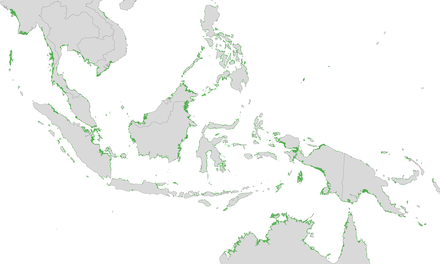

"At the limits of distribution, the formation is represented by scrubby, usually monotypicAvicennia-dominated vegetation, as at Westonport Bay and Corner Inlet, Victoria, Australia. The latter locality is the highest latitude (38° 45'S) at which mangroves occur naturally. The mangroves in New Zealand, which extend as far south as 37°, are of the same type; they start as low forest in the northern part of the North Island but become low scrub toward their southern limit. In both instances, the species is referred to asAvicennia marinavar.australis,although genetic comparison is clearly needed. In Western Australia,A. marinaextends as far south as Bunbury (33° 19'S). In the northern hemisphere, scrubbyAvicennia gerrninansin Florida occurs as far north as St. Augustine on the east coast and Cedar Point on the west. There are records ofA. germinansandRhizophoramangle for Bermuda, presumably supplied by the Gulf Stream. In southern Japan,Kandelia obovataoccurs to about 31 °N (Tagawa in Hosakawa et al., 1977, but initially referred to asK. candel). "[38]: 57
Mangrove forests
[edit]
Mangrove forests,also calledmangrove swampsormangals,are found in tropical and subtropicaltidalareas. Areas where mangroves occur includeestuariesand marine shorelines.[19]
Theintertidalexistence to which these trees are adapted represents the major limitation to the number of species able to thrive in their habitat. High tide brings in salt water, and when the tide recedes, solar evaporation of the seawater in the soil leads to further increases in salinity. The return of tide can flush out these soils, bringing them back to salinity levels comparable to that of seawater.[2][4]
At low tide, organisms are also exposed to increases in temperature and reduced moisture before being then cooled and flooded by the tide. Thus, for a plant to survive in this environment, it must tolerate broad ranges of salinity, temperature, and moisture, as well as several other key environmental factors—thus only a select few species make up the mangrove tree community.[2][4]
About 110 species are considered mangroves, in the sense of being trees that grow in such a saline swamp,[19]though only a few are from the mangrove plant genus,Rhizophora.However, a given mangrove swamp typically features only a small number of tree species. It is not uncommon for a mangrove forest in the Caribbean to feature only three or four tree species. For comparison, the tropical rainforest biome contains thousands of tree species, but this is not to say mangrove forests lack diversity. Though the trees themselves are few in species, the ecosystem that these trees create provides a home (habitat) for a great variety of other species, including as many as 174 species of marinemegafauna.[42]
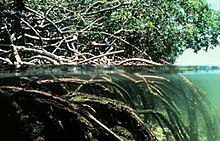
Mangrove plants require a number of physiological adaptations to overcome the problems oflow environmental oxygenlevels, highsalinity,and frequenttidal flooding.Each species has its own solutions to these problems; this may be the primary reason why, on some shorelines, mangrove tree species show distinct zonation. Small environmental variations within a mangal may lead to greatly differing methods for coping with the environment. Therefore, the mix of species is partly determined by the tolerances of individual species to physical conditions, such as tidal flooding and salinity, but may also be influenced by other factors, such as crabs preying on plant seedlings.[43]
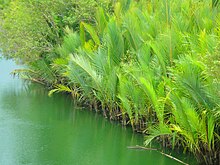
Once established, mangrove roots provide an oyster habitat and slow water flow, thereby enhancing sediment deposition in areas where it is already occurring. The fine,anoxicsediments under mangroves act as sinks for a variety ofheavy (trace) metalswhichcolloidal particlesin the sediments have concentrated from the water. Mangrove removal disturbs these underlying sediments, often creating problems of trace metal contamination of seawater and organisms of the area.[44]
Mangrove swamps protect coastal areas fromerosion,storm surge(especially duringtropical cyclones), andtsunamis.[45][46][47]They limit high-energy wave erosion mainly during events such as storm surges and tsunamis.[48] The mangroves' massive root systems are efficient at dissipating wave energy.[49]Likewise, they slow down tidal water so that its sediment is deposited as the tide comes in, leaving all except fine particles when the tide ebbs.[50]In this way, mangroves build their environments.[45]Because of the uniqueness of mangrove ecosystems and the protection against erosion they provide, they are often the object of conservation programs,[4]including nationalbiodiversity action plans.[46]
The unique ecosystem found in the intricate mesh of mangrove roots offers a quiet marine habitat for young organisms.[51]In areas where roots are permanently submerged, the organisms they host includealgae,barnacles,oysters,sponges,andbryozoans,which all require a hard surface for anchoring while they filter-feed.Shrimpsandmud lobstersuse the muddy bottoms as their home.[52]Mangrove crabseat the mangrove leaves, adding nutrients to the mangal mud for other bottom feeders.[53]In at least some cases, the export of carbon fixed in mangroves is important in coastal food webs.[54]
Mangrove forests contribute significantly to coastal ecosystems by fostering complex and diversefood webs.The intricate root systems of mangroves create a habitat conducive to the proliferation of microorganisms, crustaceans, and small fish, forming the foundational tiers of the food chain. This abundance of organisms serves as a critical food source for larger predators like birds, reptiles, and mammals within the ecosystem. Additionally, mangrove forests function as essential nurseries for many commercially important fish species, providing a sheltered environment rich in nutrients during their early life stages. The decomposition of leaves and organic matter in the water further enhances the nutrient content, supporting overall ecosystem productivity. In summary, mangrove forests play a crucial and unbiased role in sustaining biodiversity and ecological balance within coastal food webs.[55]
Larger marine organisms benefit from the habitat as a nursery for their offspring.Lemon sharksdepend on mangrove creeks to give birth to their pups. The ecosystem provides little competition and minimizes threats ofpredationto juvenile lemon sharks as they use the cover of mangroves to practice hunting before entering the food web of the ocean.[56]
Mangrove plantations in Vietnam, Thailand, Philippines, and India host several commercially important species of fish and crustaceans.[57]
The mangrove food chain extends beyond the marine ecosystem. Coastal bird species inhabit the tidal ecosystems feeding off small marine organisms and wetland insects. Common bird families found in mangroves around the world areegrets,kingfishers,herons,andhornbills,among many others dependent on ecological range.[58]Bird predation plays a key role in maintaining prey species along coastlines and within mangrove ecosystems.
Mangrove forests can decay intopeatdeposits because of fungal and bacterial processes as well as by the action oftermites.It becomes peat in goodgeochemical,sedimentary, andtectonicconditions.[59]The nature of these deposits depends on the environment and the types of mangroves involved. InPuerto Rico,thered,white,andblackmangroves occupy different ecological niches and have slightly different chemical compositions, so thecarbon contentvaries between the species, as well between the different tissues of the plant (e.g., leaf matter versus roots).[59]
In Puerto Rico, there is a clear succession of these three trees from the lower elevations, which are dominated by red mangroves, to farther inland with a higher concentration of white mangroves.[59]Mangrove forests are an important part of the cycling and storage of carbon in tropical coastal ecosystems.[59]Knowing this, scientists seek to reconstruct the environment and investigate changes to the coastal ecosystem over thousands of years using sediment cores.[60]However, an additional complication is the imported marine organic matter that also gets deposited in the sediment due to the tidal flushing of mangrove forests. Termites play an important role in the formation of peat from mangrove materials.[59]They process fallenleaf litter,root systems and wood from mangroves into peat to build their nests, and stabilise the chemistry of this peat that represents approximately 2% of above ground carbon storage in mangroves. As the nests are buried over time this carbon is stored in the sediment and the carbon cycle continues.[59]
Mangroves are an important source ofblue carbon.Globally, mangroves stored 4.19 Gt (9.2×1012lb) of carbon in 2012. Two percent of global mangrove carbon was lost between 2000 and 2012, equivalent to a maximum potential of 0.316996250 Gt (6.9885710×1011lb) of emissions ofcarbon dioxide in Earth's atmosphere.[61]
Globally, mangroves have been shown to provide measurable economic protections to coastal communities affected by tropical storms.[62]
Mangrove microbiome
[edit]Plant microbiomesplay crucial roles in the health and productivity of mangroves.[63]Many researchers have successfully applied knowledge acquired about plantmicrobiomesto produce specificinoculafor crop protection.[64][65]Such inocula can stimulate plant growth by releasing phytohormones and enhancing uptake of some mineral nutrients (particularly phosphorus and nitrogen).[65][66][67]However, most of the plant microbiome studies have focused on the model plantArabidopsis thalianaand economically important crop plants, such asrice,barley,wheat,maizeandsoybean.There is less information on the microbiomes of tree species.[63][65]Plant microbiomes are determined by plant-related factors (e.g.,genotype,organ, species, and health status) and environmental factors (e.g., land use, climate, and nutrient availability).[63][67]Two of the plant-related factors, plant species, and genotypes, have been shown to play significant roles in shapingrhizosphereand plant microbiomes, as tree genotypes and species are associated with specificmicrobial communities.[66]Different plant organs also have specific microbial communities depending on plant-associated factors (plant genotype, available nutrients, and organ-specific physicochemical conditions) and environmental conditions (associated with aboveground and underground surfaces and disturbances).[68][69][70][71]
Root microbiome
[edit]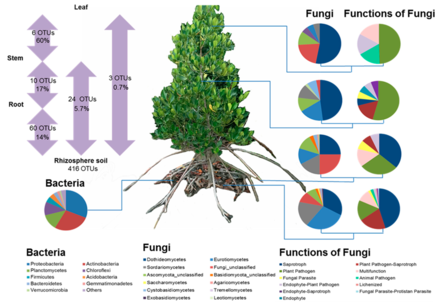
Mangrove roots harbour a repertoire ofmicrobial taxathat contribute to important ecological functions in mangrove ecosystems. Like typical terrestrial plants, mangroves depend upon mutually beneficial interactions with microbial communities.[72]In particular, microbes residing in developed roots could help mangroves transform nutrients into usable forms before plant assimilation.[73][74]These microbes also provide mangrovesphytohormonesfor suppressingphytopathogens[75]or helping mangroves withstand heat and salinity.[72]In turn, root-associated microbes receive carbonmetabolitesfrom the plant via rootexudates,[76]thus close associations between the plant and microbes are established for their mutual benefits.[77][78]
The taxonomic class level shows that mostProteobacteriawere reported to come from Gammaproteobacteria, followed by Deltaproteobacteria and Alphaproteobacteria. The diverse function and the phylogenic variation of Gammaproteobacteria, which consisted of orders such as Alteromonadales and Vibrionales, are found in marine and coastal regions and are high in abundance in mangrove sediments functioning as nutrient recyclers. Members of Deltaproteobacteria found in mangrove soil are mostly sulfur-related, consisting ofDesulfobacterales,Desulfuromonadales,Desulfovibrionales,and Desulfarculales among others.[79] Highly diverse microbial communities (mainlybacteriaandfungi) have been found to inhabit and function in mangrove roots.[80][72][81]For example,diazotrophic bacteriain the vicinity of mangrove roots could performbiological nitrogen fixation,which provides 40–60% of the total nitrogen required by mangroves;[82][83]the soil attached to mangrove roots lacks oxygen but is rich in organic matter, providing an optimal microenvironment forsulfate-reducing bacteriaandmethanogens,[72]ligninolytic,cellulolytic,andamylolyticfungi are prevalent in the mangrove root environment;[72]rhizosphere fungi could help mangroves survive in waterlogged and nutrient-restricted environments.[84]These studies have provided increasing evidence to support the importance of root-associated bacteria and fungi for mangrove growth and health.[72][73][78]
Recent studies have investigated the detailed structure of root-associated microbial communities at a continuous fine-scale in other plants,[85]where a microhabitat was divided into four root compartments: endosphere,[75][86][87]episphere,[75]rhizosphere,[86][88]and nonrhizosphere orbulk soil.[89][90]Moreover, the microbial communities in each compartment have been reported to have unique characteristics.[75][86]Root exudates selectively enrich adapted microbial populations; however, these exudates were found to exert only marginal impacts on microbes in thebulk soiloutside the rhizosphere.[91][77]Furthermore, it was noted that the root episphere, rather than the rhizosphere, was primarily responsible for controlling the entry of specific microbial populations into the root,[75]resulting in the selective enrichment of Proteobacteria in the endosphere.[75][92]These findings provide new insights into the niche differentiation of root-associated microbial communities,[75][91][77][92]Nevertheless, amplicon-based community profiling may not provide the functional characteristics of root-associated microbial communities in plant growth and biogeochemical cycling.[93]Unraveling functional patterns across the four root compartments holds a great potential for understanding functional mechanisms responsible for mediating root–microbe interactions in support of enhancing mangrove ecosystem functioning.[78]
The diversity of bacteria in disturbed mangroves is reported to be higher than in well-preserved mangroves[79]Studies comparing mangroves in different conservation states show that bacterial composition in disturbed mangrove sediment alters its structure, leading to a functional equilibrium, where the dynamics of chemicals in mangrove soils lead to the remodeling of its microbial structure.[94]
Suggestions for future mangrove microbial diversity research
[edit]Despite many research advancements in mangrove sediment bacterial metagenomics diversity in various conditions over the past few years, bridging the research gap and expanding our knowledge towards the relationship between microbes mainly constituted of bacteria and its nutrient cycles in the mangrove sediment and direct and indirect impacts on mangrove growth and stand-structures as coastal barriers and other ecological service providers. Thus, based on studies by Lai et al.'s systematic review, here they suggest sampling improvements and a fundamental environmental index for future reference.[79]
Mangrove virome
[edit]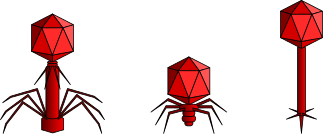

Mangrove forestsare one of the most carbon-rich biomes, accounting for 11% of the total input of terrestrial carbon into oceans.Virusesare thought to significantly influence local and globalbiogeochemical cycles,though as of 2019 little information was available about the community structure, genetic diversity and ecological roles of viruses in mangrove ecosystems.[95]
Viruses are the most abundant biological entities on earth, present in virtually all ecosystems.[96][97]Bylysingtheir hosts, that is, by rupturing their cell membranes, viruses control host abundance and affect the structure of host communities.[98]Viruses also influence their host diversity and evolution throughhorizontal gene transfer,selection for resistanceand manipulation ofbacterial metabolisms.[99][100][101]Importantly,marine virusesaffect local and globalbiogeochemical cyclesthrough the release of substantial amounts oforganic carbonand nutrients from hosts and assist microbes in driving biogeochemical cycles withauxiliary metabolic genes(AMGs).[102][103][104][95]
It is presumed AMGs augment viral-infected host metabolism and facilitate the production of new viruses.[99][105]AMGs have been extensively explored inmarine cyanophagesand include genes involved in photosynthesis, carbon turnover, phosphate uptake and stress response.[106][107][108][109]Cultivation-independent metagenomic analysis of viral communities has identified additional AMGs that are involved in motility, central carbon metabolism, photosystem I, energy metabolism, iron–sulphur clusters, anti-oxidation and sulphur and nitrogen cycling.[103][110][111][112]Interestingly, a recent analysis of Pacific Ocean Virome data identified niche-specialised AMGs that contribute to depth-stratified host adaptations.[113]Given that microbes drive global biogeochemical cycles, and a large fraction of microbes is infected by viruses at any given time,[114]viral-encoded AMGs must play important roles in global biogeochemistry and microbial metabolic evolution.[95]
Mangrove forests are the only woodyhalophytesthat live in salt water along the world's subtropical and tropical coastlines. Mangroves are one of the most productive and ecologically important ecosystems on earth. The rates of primary production of mangroves equal those of tropical humid evergreen forests and coral reefs.[115]As a globally relevant component of the carbon cycle, mangroves sequester approximately 24 million metric tons of carbon each year.[115][116]Most mangrove carbon is stored in soil and sizable belowground pools of dead roots, aiding in the conservation and recycling of nutrients beneath forests.[117]Although mangroves cover only 0.5% of the earth's coastal area, they account for 10–15% of the coastal sediment carbon storage and 10–11% of the total input of terrestrial carbon into oceans.[118]The disproportionate contribution of mangroves to carbon sequestration is now perceived as an important means to counterbalance greenhouse gas emissions.[95]

Despite the ecological importance of mangrove ecosystem, knowledge on mangrove biodiversity is notably limited. Previous reports mainly investigated the biodiversity of mangrove fauna, flora and bacterial communities.[120][121][122]Particularly, little information is available about viral communities and their roles in mangrove soil ecosystems.[123][124]In view of the importance of viruses in structuring and regulating host communities and mediating element biogeochemical cycles, exploring viral communities in mangrove ecosystems is essential. Additionally, the intermittent flooding of sea water and resulting sharp transition of mangrove environments may result in substantially different genetic and functional diversity of bacterial and viral communities in mangrove soils compared with those of other systems.[125][95]
Genome sequencing
[edit]- Rhizophoreaeas revealed bywhole-genome sequencing[126]
See also
[edit]References
[edit]- ^abcGiri, C.; Ochieng, E.; Tieszen, L. L.; Zhu, Z.; Singh, A.; Loveland, T.; Masek, J.; Duke, N. (2011)."Status and distribution of mangrove forests of the world using earth observation satellite data: Status and distributions of global mangroves".Global Ecology and Biogeography.20(1): 154–159.doi:10.1111/j.1466-8238.2010.00584.x.
- ^abcdefghFriess, D. A.; Rogers, K.; Lovelock, C. E.; Krauss, K. W.; Hamilton, S. E.; Lee, S. Y.; Lucas, R.; Primavera, J.; Rajkaran, A.; Shi, S. (2019)."The State of the World's Mangrove Forests: Past, Present, and Future".Annual Review of Environment and Resources.44(1): 89–115.doi:10.1146/annurev-environ-101718-033302.
- ^Flowers, T. J.; Colmer, T. D. (2015)."Plant salt tolerance: adaptations in halophytes".Annals of Botany.115(3): 327–331.doi:10.1093/aob/mcu267.PMC4332615.PMID25844430.
- ^abcdeZimmer, Katarina (22 July 2021)."Many mangrove restorations fail. Is there a better way?".Knowable Magazine.doi:10.1146/knowable-072221-1.Retrieved11 August2021.
- ^"Morphological and Physiological Adaptations: Florida mangrove website".Nhmi.org. Archived fromthe originalon 4 February 2012.Retrieved8 February2012.
- ^Primavera, J. H.; Savaris, J. P.; Bajoyo, B. E.; Coching, J. D.; Curnick, D. J.; Golbeque, R. L.; Guzman, A. T.; Henderin, J. Q.; Joven, R. V.; Loma, R. A.; Koldewey, H. J. (2012).Manual on community-based mangrove rehabilitation(PDF).Mangrove Manual. The Zoological Society of London ZSL. Archived fromthe original(PDF)on 1 January 2016.Retrieved15 August2021.
- ^abBunting, P.; Rosenqvist, A.; Lucas, R.; Rebelo, L.-M.; Hilarides, L.; Thomas, N.; Hardy, A.; Itoh, T.; Shimada, M.; Finlayson, C. (2018)."The Global Mangrove Watch—A New 2010 Global Baseline of Mangrove Extent".Remote Sensing.10(10): 1669.Bibcode:2018RemS...10.1669B.doi:10.3390/rs10101669.
- ^Murray, N. J.; Worthington, T. A.; Bunting, P.; Duce, S.; Hagger, V.; Lovelock, C. E.; Lucas, R.; Saunders, M. I.; Sheaves, M.; Spalding, M.; Waltham, N. J.; Lyons, M. B. (2022)."High-resolution mapping of losses and gains of Earth's tidal wetlands".Science.376(6594): 744–749.Bibcode:2022Sci...376..744M.doi:10.1126/science.abm9583.hdl:2160/55fdc0d4-aa3e-433f-8a88-2098b1372ac5.PMID35549414.S2CID248749118.
- ^R., Carol; Carlowicz, M. (2019)."New Satellite-Based maps of Mangrove heights".Retrieved15 May2019.
- ^Simard, M.; Fatoyinbo, L.; Smetanka, C.; Rivera-Monroy, V. H.; Castañeda-Moya, E.; Thomas, N.; Van der Stocken, T. (2018). "Mangrove canopy height globally related to precipitation, temperature and cyclone frequency".Nature Geoscience.12(1): 40–45.doi:10.1038/s41561-018-0279-1.hdl:2060/20190029179.S2CID134827807.
- ^"International Day for the Conservation of the Mangrove Ecosystem".UNESCO.Retrieved9 June2023.
- ^abcSaenger, P. (2013).Mangrove ecology, silviculture, and conservation(Reprint of 2002 ed.). Springer Science & Business Media.ISBN9789401599627.
- ^abcdeMacnae, W. (1969)."A General Account of the Fauna and Flora of Mangrove Swamps and Forests in the Indo-West-Pacific Region".Advances in Marine Biology.6:73–270.doi:10.1016/S0065-2881(08)60438-1.ISBN9780120261062.Retrieved13 August2021.
- ^abGörlach, M. (1 January 2003).English Words Abroad.John Benjamins Publishing. p. 59.ISBN9027223319.Retrieved13 August2021.
- ^Rafinesque, C. S.(1836).The American Nations.Vol. 1. C. S. Rafinesque. p. 244.
- ^Weekley, Ernest (1967).An Etymological Dictionary of Modern English.Vol. 2 (Reprint of 1921 ed.). Dover.ISBN9780486122861.Retrieved13 August2021.
- ^abHogarth, Peter J. (2015).The biology of mangroves and seagrasses.Oxford: Oxford university press.ISBN978-0-19-871654-9.
- ^Austin, D. F. (2004).Florida Ethnobotany.CRC Press.ISBN978-0-203-49188-1.
- ^abcMathias, M. E."Mangal (Mangrove).World Vegetation".Botanical Garden, University of California at Los Angeles.Botgard.ucla.edu. Archived fromthe originalon 9 February 2012.Retrieved8 February2012.
- ^"Distribution of coral, mangrove and seagrass diversity".Maps.grida.no. Archived fromthe originalon 5 March 2010.Retrieved8 February2012.
- ^"Red mangrove".Department of Agriculture and Fisheries, Queensland Government.January 2013.Retrieved13 August2021.
- ^"Black Mangrove (Avicennia germinans) ".The Department of Environment and Natural Resources, Government of Bermuda.Retrieved13 August2021.
- ^"Morphological and Physiological Adaptations".Newfound Harbor Marine Institute.Retrieved13 August2021.
- ^Krishnamurthy, Pannaga; Jyothi-Prakash, Pavithra A.; Qin, Lin; He, Jie; Lin, Qingsong; Loh, Chiang-Shiong; Kumar, Prakash P. (July 2014)."Role of root hydrophobic barriers in salt exclusion of a mangrove plantAvicennia officinalis".Plant, Cell & Environment.37(7): 1656–1671.doi:10.1111/pce.12272.PMID24417377.
- ^Gray, L. Joseph; et al. (2010)."Sacrificial leaf hypothesis of mangroves"(PDF).ISME/GLOMIS Electronic Journal.GLOMIS.Retrieved21 January2012.
- ^abcKim, Kiwoong; Seo, Eunseok; Chang, Suk-Kyu; Park, Tae Jung; Lee, Sang Joon (5 February 2016)."Novel water filtration of saline water in the outermost layer of mangrove roots".Scientific Reports.6(1). Springer Science and Business Media LLC: 20426.Bibcode:2016NatSR...620426K.doi:10.1038/srep20426.ISSN2045-2322.PMC4742776.PMID26846878.
 Material was copied from this source, which is available under aCreative Commons Attribution 4.0 International License.
Material was copied from this source, which is available under aCreative Commons Attribution 4.0 International License.
- ^Calfo, Anthony (2006)."Mangroves for the Marine Aquarium".Reefkeeping.Reef Central.Archivedfrom the original on 1 February 2022.Retrieved8 February2012.
- ^Tomlinson, P. The botany of mangroves. [116–130] (Cambridge University Press, Cambridge, 1986).
- ^Zheng, Wen-Jiao; Wang, Wen-Qing; Lin, Peng (1999). "Dynamics of element contents during the development of hypocotyles and leaves of certain mangrove species".Journal of Experimental Marine Biology and Ecology.233(2): 247–257.Bibcode:1999JEMBE.233..247Z.doi:10.1016/S0022-0981(98)00131-2.
- ^Parida, Asish Kumar; Jha, Bhavanath (2010). "Salt tolerance mechanisms in mangroves: A review".Trees.24(2): 199–217.Bibcode:2010Trees..24..199P.doi:10.1007/s00468-010-0417-x.S2CID3036770.
- ^Krishnamurthy, Pannaga; Jyothi-Prakash, Pavithra A.; Qin, LIN; He, JIE; Lin, Qingsong; Loh, Chiang-Shiong; Kumar, Prakash P. (2014)."Role of root hydrophobic barriers in salt exclusion of a mangrove plantAvicenniaofficinalis ".Plant, Cell & Environment.37(7): 1656–1671.doi:10.1111/pce.12272.PMID24417377.
- ^Scholander, P. F. (1968). "How Mangroves Desalinate Seawater".Physiologia Plantarum.21:251–261.doi:10.1111/j.1399-3054.1968.tb07248.x.
- ^Scholander, P. F.; Bradstreet, Edda D.; Hammel, H. T.; Hemmingsen, E. A. (1966)."Sap Concentrations in Halophytes and Some Other Plants".Plant Physiology.41(3): 529–532.doi:10.1104/pp.41.3.529.PMC1086377.PMID5906381.
- ^Drennan, Philippa; Pammenter, N. W. (1982)."Physiology of Salt Excretion in the Mangrove Avicennia Marina (Forsk.) Vierh".New Phytologist.91(4): 597–606.doi:10.1111/j.1469-8137.1982.tb03338.x.
- ^Sobrado, M.A. (2001). "Effect of high external NaClconcentration on the osmolality of xylem sap, leaf tissue and leaf glands secretion of the mangrove Avicennia germinans (L.) L ".Flora.196(1): 63–70.Bibcode:2001FMDFE.196...63S.doi:10.1016/S0367-2530(17)30013-0.
- ^Fujita, Miki; Fujita, Yasunari; Noutoshi, Yoshiteru; Takahashi, Fuminori; Narusaka, Yoshihiro; Yamaguchi-Shinozaki, Kazuko; Shinozaki, Kazuo (2006). "Crosstalk between abiotic and biotic stress responses: A current view from the points of convergence in the stress signaling networks".Current Opinion in Plant Biology.9(4): 436–442.Bibcode:2006COPB....9..436F.doi:10.1016/j.pbi.2006.05.014.PMID16759898.S2CID31166870.
- ^Hogarth, P. J. (1 January 2017),"Mangrove Ecosystems☆",Reference Module in Life Sciences,Elsevier,doi:10.1016/b978-0-12-809633-8.02209-3,ISBN978-0-12-809633-8,retrieved1 March2024
- ^abcdeTomlinson, P. B. (2016).The botany of mangroves.Cambridge, United Kingdom: Cambridge University Press.ISBN978-1-107-08067-6.OCLC946579968.
- ^Ricklefs, R. E.; A. Schwarzbach; S. S. Renner (2006)."Rate of lineage origin explains the diversity anomaly in the world's mangrove vegetation"(PDF).American Naturalist.168(6): 805–810.doi:10.1086/508711.PMID17109322.S2CID1493815.Archived fromthe original(PDF)on 16 June 2013.
- ^abPolidoro, Beth A.; Carpenter, Kent E.; Collins, Lorna; Duke, Norman C.; Ellison, Aaron M.; Ellison, Joanna C.; Farnsworth, Elizabeth J.; Fernando, Edwino S.; Kathiresan, Kandasamy; Koedam, Nico E.; Livingstone, Suzanne R.; Miyagi, Toyohiko; Moore, Gregg E.; Ngoc Nam, Vien; Ong, Jin Eong; Primavera, Jurgenne H.; Salmo, Severino G.; Sanciangco, Jonnell C.; Sukardjo, Sukristijono; Wang, Yamin; Yong, Jean Wan Hong (2010)."The Loss of Species: Mangrove Extinction Risk and Geographic Areas of Global Concern".PLOS ONE.5(4): e10095.Bibcode:2010PLoSO...510095P.doi:10.1371/journal.pone.0010095.PMC2851656.PMID20386710.
 Material was copied from this source, which is available under aCreative Commons Attribution 4.0 International License.
Material was copied from this source, which is available under aCreative Commons Attribution 4.0 International License.
- ^"Mapping Mangroves by Satellite".earthobservatory.nasa.gov.30 November 2010.
- ^Sievers, M.; Brown, C. J.; Tulloch, V. J. D.; Pearson, R. M.; Haig, J. A.; Turschwell, M. P.; Connolly, R. M. (2019). "The Role of Vegetated Coastal Wetlands for Marine Megafauna Conservation".Trends in Ecology & Evolution.34(9): 807–817.Bibcode:2019TEcoE..34..807S.doi:10.1016/j.tree.2019.04.004.hdl:10072/391960.PMID31126633.S2CID164219103.
- ^Cannicci, S.; Fusi, M.; Cimó, F.; Dahdouh-Guebas, F.; Fratini, S. (2018)."Interference competition as a key determinant for spatial distribution of mangrove crabs".BMC Ecology.18(1): 8.Bibcode:2018BMCE...18....8C.doi:10.1186/s12898-018-0164-1.PMC5815208.PMID29448932.
- ^Saenger, P.; McConchie, D. (2004). "Heavy metals in mangroves: methodology, monitoring and management".Envis Forest Bulletin.4:52–62.CiteSeerX10.1.1.961.9649.
- ^abMazda, Y.; Kobashi, D.; Okada, S. (2005). "Tidal-Scale Hydrodynamics within Mangrove Swamps".Wetlands Ecology and Management.13(6): 647–655.Bibcode:2005WetEM..13..647M.CiteSeerX10.1.1.522.5345.doi:10.1007/s11273-005-0613-4.S2CID35322400.
- ^abDanielsen, F.; Sørensen, M. K.; Olwig, M. F.; Selvam, V.; Parish, F.; Burgess, N. D.; Hiraishi, T.; Karunagaran, V. M.; Rasmussen, M. S.; Hansen, L. B.; Quarto, A.; Suryadiputra, N. (2005). "The Asian Tsunami: A Protective Role for Coastal Vegetation".Science.310(5748): 643.doi:10.1126/science.1118387.PMID16254180.S2CID31945341.
- ^Takagi, H.; Mikami, T.; Fujii, D.; Esteban, M.; Kurobe, S. (2016)."Mangrove forest against dyke-break-induced tsunami on rapidly subsiding coasts".Natural Hazards and Earth System Sciences.16(7): 1629–1638.Bibcode:2016NHESS..16.1629T.doi:10.5194/nhess-16-1629-2016.
- ^Dahdouh-Guebas, F.; Jayatissa, L. P.; Di Nitto, D.; Bosire, J. O.; Lo Seen, D.; Koedam, N. (2005)."How effective were mangroves as a defence against the recent tsunami?".Current Biology.15(12): R443–447.doi:10.1016/j.cub.2005.06.008.PMID15964259.S2CID8772526.
- ^Massel, S. R.; Furukawa, K.; Brinkman, R. M. (1999). "Surface wave propagation in mangrove forests".Fluid Dynamics Research.24(4): 219.Bibcode:1999FlDyR..24..219M.doi:10.1016/s0169-5983(98)00024-0.S2CID122572658.
- ^Mazda, Y.; Wolanski, E.; King, B.; Sase, A.; Ohtsuka, D.; Magi, M. (1997). "Drag force due to vegetation in mangrove swamps".Mangroves and Salt Marshes.1(3): 193.doi:10.1023/A:1009949411068.S2CID126945589.
- ^Bos, A. R.; Gumanao, G. S.; Van Katwijk, M. M.; Mueller, B.; Saceda, M. M.; Tejada, R. L. (2010)."Ontogenetic habitat shift, population growth, and burrowing behavior of the Indo-Pacific beach star,Archaster typicus(Echinodermata; Asteroidea) ".Marine Biology.158(3): 639–648.doi:10.1007/s00227-010-1588-0.PMC3873073.PMID24391259.
- ^EncartaEncyclopedia 2005."Seashore", byHeidi Nepf.
- ^Skov, M. W.; Hartnoll, R.G. (2002). "Paradoxical selective feeding on a low-nutrient diet: Why do mangrove crabs eat leaves?".Oecologia.131(1): 1–7.Bibcode:2002Oecol.131....1S.doi:10.1007/s00442-001-0847-7.PMID28547499.S2CID23407273.
- ^Abrantes, K. G.; Johnston, R.; Connolly, R. M.; Sheaves, M. (2015). "Importance of Mangrove Carbon for Aquatic Food Webs in Wet–Dry Tropical Estuaries".Estuaries and Coasts.38(1): 383–399.Bibcode:2015EstCo..38..383A.doi:10.1007/s12237-014-9817-2.hdl:10072/141734.ISSN1559-2731.S2CID3957868.
- ^Muro-Torres, Victor M.; Amezcua, Felipe; Soto-Jiménez, Martin; Balart, Eduardo F.; Serviere-Zaragoza, Elisa; Green, Lucinda; Rajnohova, Jana (5 November 2020)."Primary Sources and Food Web Structure of a Tropical Wetland with High Density of Mangrove Forest".Water.12(11): 3105.doi:10.3390/w12113105.hdl:1854/LU-01HV3XGJPZJE3Z72394VV0MRJB.ISSN2073-4441.
- ^Newman, Sp; Handy, Rd; Gruber, Sh (5 January 2010)."Diet and prey preference of juvenile lemon sharks Negaprion brevirostris".Marine Ecology Progress Series.398:221–234.Bibcode:2010MEPS..398..221N.doi:10.3354/meps08334.ISSN0171-8630.
- ^Gupta, S. K.; Goyal, M. R. (2017).Soil Salinity Management in Agriculture: Technological Advances and Applications.CRC Press.ISBN978-1-315-34177-4.
- ^Mohd-Taib, Farah Shafawati; Mohd-Saleh, Wardah; Asyikha, Rosha; Mansor, Mohammad Saiful; Ahmad-Mustapha, Muzzneena; Mustafa-Bakray, Nur Aqilah; Mod-Husin, Shahril; Md-Shukor, Aisah; Amat-Darbis, Nurul Darsani; Sulaiman, Norela (June 2020)."Effects of anthropogenic disturbance on the species assemblages of birds in the back mangrove forests".Wetlands Ecology and Management.28(3): 479–494.Bibcode:2020WetEM..28..479M.doi:10.1007/s11273-020-09726-z.ISSN0923-4861.S2CID218484236.
- ^abcdefVane, C. H.; Kim, A. W.; Moss-Hayes, V.; Snape, C. E.; Diaz, M. C.; Khan, N. S.; Engelhart, S. E.; Horton, B. P. (2013)."Degradation of mangrove tissues by arboreal termites (Nasutitermes acajutlae) and their role in the mangrove C cycle (Puerto Rico): Chemical characterization and organic matter provenance using bulk δ13C, C/N, alkaline CuO oxidation-GC/MS, and solid-state ".Geochemistry, Geophysics, Geosystems.14(8): 3176.Bibcode:2013GGG....14.3176V.doi:10.1002/ggge.20194.
- ^Versteegh, G.J.; et al. (2004). "Taraxerol and Rhizophora pollen as proxies for tracking past mangrove ecosystems".Geochimica et Cosmochimica Acta.68(3): 411–22.Bibcode:2004GeCoA..68..411V.doi:10.1016/S0016-7037(03)00456-3.
- ^Hamilton, S. E.; Friess, D. A. (2018). "Global carbon stocks and potential emissions due to mangrove deforestation from 2000 to 2012".Nature Climate Change.8(3): 240–244.arXiv:1611.00307.Bibcode:2018NatCC...8..240H.doi:10.1038/s41558-018-0090-4.S2CID89785740.
- ^Hochard, J. P.; Hamilton, S.; Barbier, E. B. (2019)."Mangroves shelter coastal economic activity from cyclones".Proceedings of the National Academy of Sciences.116(25): 12232–12237.Bibcode:2019PNAS..11612232H.doi:10.1073/pnas.1820067116.PMC6589649.PMID31160457.
- ^abcPurahong, Witoon; Orrù, Luigi; Donati, Irene; Perpetuini, Giorgia; Cellini, Antonio; Lamontanara, Antonella; Michelotti, Vania; Tacconi, Gianni; Spinelli, Francesco (2018)."Plant Microbiome and Its Link to Plant Health: Host Species, Organs and Pseudomonas syringae pv. Actinidiae Infection Shaping Bacterial Phyllosphere Communities of Kiwifruit Plants".Frontiers in Plant Science.9:1563.doi:10.3389/fpls.2018.01563.PMC6234494.PMID30464766.
- ^Afzal, A.; Bano, A. (2008)."Rhizobium and phosphate solubilizing bacteria improve the yield and phosphorus uptake in wheat (Triticum aestivum) ".International Journal of Agriculture and Biology (Pakistan).10(1): 85–88.eISSN1814-9596.ISSN1560-8530.
- ^abcBusby, Posy E.; Soman, Chinmay; Wagner, Maggie R.; Friesen, Maren L.; Kremer, James; Bennett, Alison; Morsy, Mustafa; Eisen, Jonathan A.; Leach, Jan E.; Dangl, Jeffery L. (2017)."Research priorities for harnessing plant microbiomes in sustainable agriculture".PLOS Biology.15(3): e2001793.doi:10.1371/journal.pbio.2001793.PMC5370116.PMID28350798.
- ^abBerendsen, Roeland L.; Pieterse, Corné M.J.; Bakker, Peter A. H. M. (2012). "The rhizosphere microbiome and plant health".Trends in Plant Science.17(8): 478–486.Bibcode:2012TPS....17..478B.doi:10.1016/j.tplants.2012.04.001.hdl:1874/255269.PMID22564542.S2CID32900768.
- ^abBringel, Françoise; Couée, Ivan (2015)."Pivotal roles of phyllosphere microorganisms at the interface between plant functioning and atmospheric trace gas dynamics".Frontiers in Microbiology.06:486.doi:10.3389/fmicb.2015.00486.PMC4440916.PMID26052316.
- ^Coleman-Derr, Devin; Desgarennes, Damaris; Fonseca-Garcia, Citlali; Gross, Stephen; Clingenpeel, Scott; Woyke, Tanja; North, Gretchen; Visel, Axel; Partida-Martinez, Laila P.; Tringe, Susannah G. (2016)."Plant compartment and biogeography affect microbiome composition in cultivated and native Agave species".New Phytologist.209(2): 798–811.doi:10.1111/nph.13697.PMC5057366.PMID26467257.
- ^Cregger, M. A.; Veach, A. M.; Yang, Z. K.; Crouch, M. J.; Vilgalys, R.; Tuskan, G. A.; Schadt, C. W. (2018)."The Populus holobiont: Dissecting the effects of plant niches and genotype on the microbiome".Microbiome.6(1): 31.doi:10.1186/s40168-018-0413-8.PMC5810025.PMID29433554.
- ^Hacquard, Stéphane (2016)."Disentangling the factors shaping microbiota composition across the plant holobiont".New Phytologist.209(2): 454–457.doi:10.1111/nph.13760.hdl:11858/00-001M-0000-002B-166F-5.PMID26763678.
- ^abPurahong, Witoon; Sadubsarn, Dolaya; Tanunchai, Benjawan; Wahdan, Sara Fareed Mohamed; Sansupa, Chakriya; Noll, Matthias; Wu, Yu-Ting; Buscot, François (2019)."First Insights into the Microbiome of a Mangrove Tree Reveal Significant Differences in Taxonomic and Functional Composition among Plant and Soil Compartments".Microorganisms.7(12): 585.doi:10.3390/microorganisms7120585.PMC6955992.PMID31756976.
 Material was copied from this source, which is available under aCreative Commons Attribution 4.0 International License.
Material was copied from this source, which is available under aCreative Commons Attribution 4.0 International License.
- ^abcdefThatoi, Hrudayanath; Behera, Bikash Chandra; Mishra, Rashmi Ranjan; Dutta, Sushil Kumar (2013)."Biodiversity and biotechnological potential of microorganisms from mangrove ecosystems: A review".Annals of Microbiology.63:1–19.doi:10.1007/s13213-012-0442-7.S2CID17798850.
- ^abLiu, Xingyu; Yang, Chao; Yu, Xiaoli; Yu, Huang; Zhuang, Wei; Gu, Hang; Xu, Kui; Zheng, Xiafei; Wang, Cheng; Xiao, Fanshu; Wu, Bo; He, Zhili; Yan, Qingyun (2020). "Revealing structure and assembly for rhizophyte-endophyte diazotrophic community in mangrove ecosystem after introduced Sonneratia apetala and Laguncularia racemosa".Science of the Total Environment.721:137807.Bibcode:2020ScTEn.72137807L.doi:10.1016/j.scitotenv.2020.137807.PMID32179356.S2CID212739128.
- ^Xu, Jin; Zhang, Yunzeng; Zhang, Pengfan; Trivedi, Pankaj; Riera, Nadia; Wang, Yayu; Liu, Xin; Fan, Guangyi; Tang, Jiliang; Coletta-Filho, Helvécio D.; Cubero, Jaime; Deng, Xiaoling; Ancona, Veronica; Lu, Zhanjun; Zhong, Balian; Roper, M. Caroline; Capote, Nieves; Catara, Vittoria; Pietersen, Gerhard; Vernière, Christian; Al-Sadi, Abdullah M.; Li, Lei; Yang, Fan; Xu, Xun; Wang, Jian; Yang, Huanming; Jin, Tao; Wang, Nian (2018)."The structure and function of the global citrus rhizosphere microbiome".Nature Communications.9(1): 4894.Bibcode:2018NatCo...9.4894X.doi:10.1038/s41467-018-07343-2.PMC6244077.PMID30459421.
- ^abcdefgDurán, Paloma; Thiergart, Thorsten; Garrido-Oter, Ruben; Agler, Matthew; Kemen, Eric; Schulze-Lefert, Paul; Hacquard, Stéphane (2018)."Microbial Interkingdom Interactions in Roots Promote Arabidopsis Survival".Cell.175(4): 973–983.e14.doi:10.1016/j.cell.2018.10.020.PMC6218654.PMID30388454.
- ^Sasse, Joelle; Martinoia, Enrico; Northen, Trent (2018)."Feed Your Friends: Do Plant Exudates Shape the Root Microbiome?"(PDF).Trends in Plant Science.23(1). Elsevier BV: 25–41.Bibcode:2018TPS....23...25S.doi:10.1016/j.tplants.2017.09.003.ISSN1360-1385.OSTI1532289.PMID29050989.S2CID205455681.
- ^abcBais, Harsh P.; Weir, Tiffany L.; Perry, Laura G.; Gilroy, Simon; Vivanco, Jorge M. (2006). "The Role of Root Exudates in Rhizosphere Interactions with Plants and Other Organisms".Annual Review of Plant Biology.57:233–266.doi:10.1146/annurev.arplant.57.032905.105159.PMID16669762.
- ^abcZhuang, Wei; Yu, Xiaoli; Hu, Ruiwen; Luo, Zhiwen; Liu, Xingyu; Zheng, Xiafei; Xiao, Fanshu; Peng, Yisheng; He, Qiang; Tian, Yun; Yang, Tony; Wang, Shanquan; Shu, Longfei; Yan, Qingyun; Wang, Cheng; He, Zhili (2020)."Diversity, function and assembly of mangrove root-associated microbial communities at a continuous fine-scale".npj Biofilms and Microbiomes.6(1): 52.doi:10.1038/s41522-020-00164-6.PMC7665043.PMID33184266.
 Material was copied from this source, which is available under aCreative Commons Attribution 4.0 International License.
Material was copied from this source, which is available under aCreative Commons Attribution 4.0 International License.
- ^abcLai, Jiayong; Cheah, Wee; Palaniveloo, Kishneth; Suwa, Rempei; Sharma, Sahadev (16 December 2022)."A Systematic Review of the Physicochemical and Microbial Diversity of Well-Preserved, Restored, and Disturbed Mangrove Forests: What Is Known and What Is the Way Forward?".Forests.13(12): 2160.doi:10.3390/f13122160.
- ^Srikanth, Sandhya; Lum, Shawn Kaihekulani Yamauchi; Chen, Zhong (2016). "Mangrove root: Adaptations and ecological importance".Trees.30(2): 451–465.Bibcode:2016Trees..30..451S.doi:10.1007/s00468-015-1233-0.S2CID5471541.
- ^McKee, Karen L. (1993). "Soil Physicochemical Patterns and Mangrove Species Distribution--Reciprocal Effects?".Journal of Ecology.81(3): 477–487.Bibcode:1993JEcol..81..477M.doi:10.2307/2261526.JSTOR2261526.
- ^Holguin, Gina; Vazquez, Patricia; Bashan, Yoav (2001). "The role of sediment microorganisms in the productivity, conservation, and rehabilitation of mangrove ecosystems: An overview".Biology and Fertility of Soils.33(4): 265–278.Bibcode:2001BioFS..33..265H.doi:10.1007/s003740000319.S2CID10826862.
- ^Reef, R.; Feller, I. C.; Lovelock, C. E. (2010)."Nutrition of mangroves".Tree Physiology.30(9): 1148–1160.doi:10.1093/treephys/tpq048.PMID20566581.
- ^Xie, Xiangyu; Weng, Bosen; Cai, Bangping; Dong, Yiran; Yan, Chongling (2014). "Effects of arbuscular mycorrhizal inoculation and phosphorus supply on the growth and nutrient uptake of Kandelia obovata (Sheue, Liu & Yong) seedlings in autoclaved soil".Applied Soil Ecology.75:162–171.Bibcode:2014AppSE..75..162X.doi:10.1016/j.apsoil.2013.11.009.
- ^Edwards, Joseph; Johnson, Cameron; Santos-Medellín, Christian; Lurie, Eugene; Podishetty, Natraj Kumar; Bhatnagar, Srijak; Eisen, Jonathan A.; Sundaresan, Venkatesan (20 January 2015)."Structure, variation, and assembly of the root-associated microbiomes of rice".Proceedings of the National Academy of Sciences.112(8): E911–E920.Bibcode:2015PNAS..112E.911E.doi:10.1073/pnas.1414592112.ISSN0027-8424.PMC4345613.PMID25605935.
- ^abcEdwards, Joseph; Johnson, Cameron; Santos-Medellín, Christian; Lurie, Eugene; Podishetty, Natraj Kumar; Bhatnagar, Srijak; Eisen, Jonathan A.; Sundaresan, Venkatesan (2015)."Structure, variation, and assembly of the root-associated microbiomes of rice".Proceedings of the National Academy of Sciences.112(8): E911–E920.Bibcode:2015PNAS..112E.911E.doi:10.1073/pnas.1414592112.PMC4345613.PMID25605935.
- ^Hartman, Kyle; Tringe, Susannah G. (2019)."Interactions between plants and soil shaping the root microbiome under abiotic stress".Biochemical Journal.476(19): 2705–2724.doi:10.1042/BCJ20180615.PMC6792034.PMID31654057.
- ^Reinhold-Hurek, Barbara; Bünger, Wiebke; Burbano, Claudia Sofía; Sabale, Mugdha; Hurek, Thomas (2015). "Roots Shaping Their Microbiome: Global Hotspots for Microbial Activity".Annual Review of Phytopathology.53:403–424.doi:10.1146/annurev-phyto-082712-102342.PMID26243728.
- ^Liu, Yalong; Ge, Tida; Ye, Jun; Liu, Shoulong; Shibistova, Olga; Wang, Ping; Wang, Jingkuan; Li, Yong; Guggenberger, Georg;Kuzyakov, Yakov;Wu, Jinshui (2019). "Initial utilization of rhizodeposits with rice growth in paddy soils: Rhizosphere and N fertilization effects".Geoderma.338:30–39.Bibcode:2019Geode.338...30L.doi:10.1016/j.geoderma.2018.11.040.S2CID134648694.
- ^Johansson, Jonas F.; Paul, Leslie R.; Finlay, Roger D. (2004)."Microbial interactions in the mycorrhizosphere and their significance for sustainable agriculture".FEMS Microbiology Ecology.48(1): 1–13.Bibcode:2004FEMME..48....1J.doi:10.1016/j.femsec.2003.11.012.PMID19712426.S2CID22700384.
- ^abSasse, Joelle; Martinoia, Enrico; Northen, Trent (2018)."Feed Your Friends: Do Plant Exudates Shape the Root Microbiome?"(PDF).Trends in Plant Science.23(1): 25–41.Bibcode:2018TPS....23...25S.doi:10.1016/j.tplants.2017.09.003.OSTI1532289.PMID29050989.S2CID205455681.
- ^abOfek-Lalzar, Maya; Sela, Noa; Goldman-Voronov, Milana; Green, Stefan J.; Hadar, Yitzhak; Minz, Dror (2014)."Niche and host-associated functional signatures of the root surface microbiome".Nature Communications.5:4950.Bibcode:2014NatCo...5.4950O.doi:10.1038/ncomms5950.PMID25232638.
- ^Liu, Yong-Xin; Qin, Yuan; Chen, Tong; Lu, Meiping; Qian, Xubo; Guo, Xiaoxuan; Bai, Yang (2021)."A practical guide to amplicon and metagenomic analysis of microbiome data".Protein & Cell.12(5): 315–330.doi:10.1007/s13238-020-00724-8.PMC8106563.PMID32394199.
- ^Cotta, Simone Raposo; Cadete, Luana Lira; Van Elsas, Jan Dirk; Andreote, Fernando Dini; Dias, Armando Cavalcante Franco (2019)."Exploring bacterial functionality in mangrove sediments and its capability to overcome anthropogenic activity".Marine Pollution Bulletin.141:586–594.Bibcode:2019MarPB.141..586C.doi:10.1016/j.marpolbul.2019.03.001.PMID30955771.S2CID91872087.
- ^abcdefJin, Min; Guo, Xun; Zhang, Rui; Qu, Wu; Gao, Boliang; Zeng, Runying (2019)."Diversities and potential biogeochemical impacts of mangrove soil viruses".Microbiome.7(1): 58.doi:10.1186/s40168-019-0675-9.PMC6460857.PMID30975205.
 Material was copied from this source, which is available under aCreative Commons Attribution 4.0 International License.
Material was copied from this source, which is available under aCreative Commons Attribution 4.0 International License.
- ^Suttle, Curtis A. (2005). "Viruses in the sea".Nature.437(7057): 356–361.Bibcode:2005Natur.437..356S.doi:10.1038/nature04160.PMID16163346.S2CID4370363.
- ^Holmfeldt, K.; Solonenko, N.; Shah, M.; Corrier, K.; Riemann, L.; Verberkmoes, N. C.; Sullivan, M. B. (2013)."Twelve previously unknown phage genera are ubiquitous in global oceans".Proceedings of the National Academy of Sciences.110(31): 12798–12803.Bibcode:2013PNAS..11012798H.doi:10.1073/pnas.1305956110.PMC3732932.PMID23858439.
- ^Sime-Ngando, TéLesphore (2014)."Environmental bacteriophages: Viruses of microbes in aquatic ecosystems".Frontiers in Microbiology.5:355.doi:10.3389/fmicb.2014.00355.PMC4109441.PMID25104950.
- ^abBreitbart, Mya (2012). "Marine Viruses: Truth or Dare".Annual Review of Marine Science.4:425–448.Bibcode:2012ARMS....4..425B.doi:10.1146/annurev-marine-120709-142805.PMID22457982.
- ^He, Tianliang; Li, Hongyun; Zhang, Xiaobo (2017)."Deep-Sea Hydrothermal Vent Viruses Compensate for Microbial Metabolism in Virus-Host Interactions".mBio.8(4).doi:10.1128/mBio.00893-17.PMC5513705.PMID28698277.
- ^Hurwitz, B. L.; Westveld, A. H.; Brum, J. R.; Sullivan, M. B. (2014)."Modeling ecological drivers in marine viral communities using comparative metagenomics and network analyses".Proceedings of the National Academy of Sciences.111(29): 10714–10719.Bibcode:2014PNAS..11110714H.doi:10.1073/pnas.1319778111.PMC4115555.PMID25002514.
- ^Anantharaman, Karthik; Duhaime, Melissa B.; Breier, John A.; Wendt, Kathleen A.; Toner, Brandy M.; Dick, Gregory J. (2014). "Sulfur Oxidation Genes in Diverse Deep-Sea Viruses".Science.344(6185): 757–760.Bibcode:2014Sci...344..757A.doi:10.1126/science.1252229.hdl:1912/6700.PMID24789974.S2CID692770.
- ^abYork, Ashley (2017)."Algal virus boosts nitrogen uptake in the ocean".Nature Reviews Microbiology.15(10): 573.doi:10.1038/nrmicro.2017.113.PMID28900307.S2CID19473466.
- ^Roux, Simon; Brum, Jennifer R.; Dutilh, Bas E.; Sunagawa, Shinichi; Duhaime, Melissa B.; Loy, Alexander; Poulos, Bonnie T.; Solonenko, Natalie; Lara, Elena; Poulain, Julie; Pesant, Stéphane; Kandels-Lewis, Stefanie; Dimier, Céline; Picheral, Marc; Searson, Sarah; Cruaud, Corinne; Alberti, Adriana; Duarte, Carlos M.; Gasol, Josep M.; Vaqué, Dolors; Bork, Peer; Acinas, Silvia G.; Wincker, Patrick; Sullivan, Matthew B. (2016). "Ecogenomics and potential biogeochemical impacts of globally abundant ocean viruses".Nature.537(7622): 689–693.Bibcode:2016Natur.537..689..doi:10.1038/nature19366.hdl:1874/341494.PMID27654921.S2CID54182070.
- ^Rohwer, Forest; Thurber, Rebecca Vega (2009). "Viruses manipulate the marine environment".Nature.459(7244): 207–212.Bibcode:2009Natur.459..207R.doi:10.1038/nature08060.PMID19444207.S2CID4397295.
- ^Sullivan, Matthew B.;Lindell, Debbie;Lee, Jessica A.; Thompson, Luke R.; Bielawski, Joseph P.; Chisholm, Sallie W. (2006)."Prevalence and Evolution of Core Photosystem II Genes in Marine Cyanobacterial Viruses and Their Hosts".PLOS Biology.4(8): e234.doi:10.1371/journal.pbio.0040234.PMC1484495.PMID16802857.
- ^Thompson, L. R.; Zeng, Q.; Kelly, L.; Huang, K. H.; Singer, A. U.; Stubbe, J.; Chisholm, S. W. (2011)."Phage auxiliary metabolic genes and the redirection of cyanobacterial host carbon metabolism".Proceedings of the National Academy of Sciences.108(39): E757–E764.doi:10.1073/pnas.1102164108.PMC3182688.PMID21844365.
- ^Zeng, Qinglu; Chisholm, Sallie W. (2012)."Marine Viruses Exploit Their Host's Two-Component Regulatory System in Response to Resource Limitation".Current Biology.22(2): 124–128.Bibcode:2012CBio...22..124Z.doi:10.1016/j.cub.2011.11.055.hdl:1721.1/69047.PMID22244998.S2CID7692657.
- ^Frank, Jeremy A.; Lorimer, Don; Youle, Merry; Witte, Pam; Craig, Tim; Abendroth, Jan; Rohwer, Forest; Edwards, Robert A.; Segall, Anca M.; Burgin, Alex B. (2013)."Structure and function of a cyanophage-encoded peptide deformylase".The ISME Journal.7(6): 1150–1160.Bibcode:2013ISMEJ...7.1150F.doi:10.1038/ismej.2013.4.PMC3660681.PMID23407310.
- ^Yooseph, Shibu; et al. (2007)."The Sorcerer II Global Ocean Sampling Expedition: Expanding the Universe of Protein Families".PLOS Biology.5(3): e16.doi:10.1371/journal.pbio.0050016.PMC1821046.PMID17355171.
- ^Dinsdale, Elizabeth A.; Edwards, Robert A.; Hall, Dana; Angly, Florent; Breitbart, Mya; Brulc, Jennifer M.; Furlan, Mike; Desnues, Christelle; Haynes, Matthew; Li, Linlin; McDaniel, Lauren; Moran, Mary Ann; Nelson, Karen E.; Nilsson, Christina; Olson, Robert; Paul, John; Brito, Beltran Rodriguez; Ruan, Yijun; Swan, Brandon K.; Stevens, Rick; Valentine, David L.; Thurber, Rebecca Vega; Wegley, Linda; White, Bryan A.; Rohwer, Forest (2008). "Functional metagenomic profiling of nine biomes".Nature.452(7187): 629–632.Bibcode:2008Natur.452..629D.doi:10.1038/nature06810.PMID18337718.S2CID4421951.
- ^Rosenwasser, Shilo; Ziv, Carmit; Creveld, Shiri Graff van; Vardi, Assaf (2016). "Virocell Metabolism: Metabolic Innovations During Host–Virus Interactions in the Ocean".Trends in Microbiology.24(10): 821–832.doi:10.1016/j.tim.2016.06.006.PMID27395772.
- ^Hurwitz, Bonnie L.; Brum, Jennifer R.; Sullivan, Matthew B. (2015)."Depth-stratified functional and taxonomic niche specialization in the 'core' and 'flexible' Pacific Ocean Virome".The ISME Journal.9(2): 472–484.Bibcode:2015ISMEJ...9..472H.doi:10.1038/ismej.2014.143.PMC4303639.PMID25093636.
- ^Wommack, K. Eric; Colwell, Rita R. (2000)."Virioplankton: Viruses in Aquatic Ecosystems".Microbiology and Molecular Biology Reviews.64(1): 69–114.doi:10.1128/MMBR.64.1.69-114.2000.PMC98987.PMID10704475.
- ^abAlongi, Daniel M. (2012)."Carbon sequestration in mangrove forests".Carbon Management.3(3): 313–322.Bibcode:2012CarM....3..313A.doi:10.4155/cmt.12.20.S2CID153827173.
- ^Jennerjahn, Tim C.; Ittekkot, Venugopalan (2002). "Relevance of mangroves for the production and deposition of organic matter along tropical continental margins".Naturwissenschaften.89(1): 23–30.Bibcode:2002NW.....89...23J.doi:10.1007/s00114-001-0283-x.PMID12008969.S2CID33556308.
- ^Alongi, Daniel M.; Clough, Barry F.; Dixon, Paul; Tirendi, Frank (2003). "Nutrient partitioning and storage in arid-zone forests of the mangroves Rhizophora stylosa and Avicennia marina".Trees.17(1): 51–60.Bibcode:2003Trees..17...51A.doi:10.1007/s00468-002-0206-2.S2CID23613917.
- ^Alongi, Daniel M. (2014)."Carbon Cycling and Storage in Mangrove Forests".Annual Review of Marine Science.6:195–219.Bibcode:2014ARMS....6..195A.doi:10.1146/annurev-marine-010213-135020.PMID24405426.
- ^Natarajan, Purushothaman; Murugesan, Ashok Kumar; Govindan, Ganesan; Gopalakrishnan, Ayyaru; Kumar, Ravichandiran; Duraisamy, Purushothaman; Balaji, Raju; Shyamli, Puhan Sushree; Parida, Ajay K.; Parani, Madasamy (8 July 2021)."A reference-grade genome identifies salt-tolerance genes from the salt-secreting mangrove species Avicennia marina".Communications Biology.4(1). Springer Science and Business Media LLC: 851.doi:10.1038/s42003-021-02384-8.ISSN2399-3642.PMC8266904.PMID34239036.
 Material was copied from this source, which is available under aCreative Commons Attribution 4.0 International License.
Material was copied from this source, which is available under aCreative Commons Attribution 4.0 International License.
- ^Marcial Gomes, Newton C.; Borges, Ludmila R.; Paranhos, Rodolfo; Pinto, Fernando N.; Mendonã§a-Hagler, Leda C. S.; Smalla, Kornelia (2008). "Exploring the diversity of bacterial communities in sediments of urban mangrove forests".FEMS Microbiology Ecology.66(1): 96–109.Bibcode:2008FEMME..66...96M.doi:10.1111/j.1574-6941.2008.00519.x.PMID18537833.S2CID40733636.
- ^Andreote, Fernando Dini; Jiménez, Diego Javier; Chaves, Diego; Dias, Armando Cavalcante Franco; Luvizotto, Danice Mazzer; Dini-Andreote, Francisco; Fasanella, Cristiane Cipola; Lopez, Maryeimy Varon; Baena, Sandra; Taketani, Rodrigo Gouvêa; De Melo, Itamar Soares (2012)."The Microbiome of Brazilian Mangrove Sediments as Revealed by Metagenomics".PLOS ONE.7(6): e38600.Bibcode:2012PLoSO...738600A.doi:10.1371/journal.pone.0038600.PMC3380894.PMID22737213.
- ^Ricklefs, Robert E.; Schluter, Dolph (1993).Species Diversity in Ecological Communities: Historical and Geographical Perspectives.University of Chicago Press.ISBN9780226718231.
- ^Pratama, Akbar Adjie; Van Elsas, Jan Dirk (2018). "The 'Neglected' Soil Virome – Potential Role and Impact".Trends in Microbiology.26(8): 649–662.doi:10.1016/j.tim.2017.12.004.PMID29306554.S2CID25057850.
- ^Williamson, Kurt E.; Fuhrmann, Jeffry J.; Wommack, K. Eric; Radosevich, Mark (2017)."Viruses in Soil Ecosystems: An Unknown Quantity within an Unexplored Territory".Annual Review of Virology.4(1): 201–219.doi:10.1146/annurev-virology-101416-041639.PMID28961409.
- ^Liang, Jun-Bin; Chen, Yue-Qin; Lan, Chong-Yu; Tam, Nora F. Y.; Zan, Qi-Jie; Huang, Li-Nan (2007). "Recovery of novel bacterial diversity from mangrove sediment".Marine Biology.150(5): 739–747.Bibcode:2007MarBi.150..739L.doi:10.1007/s00227-006-0377-2.S2CID85384181.
- ^Xu, Shaohua; He, Ziwen; Zhang, Zhang; Guo, Zixiao; Guo, Wuxia; Lyu, Haomin; Li, Jianfang; Yang, Ming; Du, Zhenglin; Huang, Yelin; Zhou, Renchao; Zhong, Cairong; Boufford, David E; Lerdau, Manuel; Wu, Chung-I; Duke, Norman C.; Shi, Suhua (5 June 2017)."The origin, diversification and adaptation of a major mangrove clade (Rhizophoreae) revealed by whole-genome sequencing".National Science Review.4(5). Oxford University Press (OUP): 721–734.doi:10.1093/nsr/nwx065.ISSN2095-5138.PMC6599620.PMID31258950.
Further reading
[edit]- Saenger, Peter (2002).Mangrove Ecology, Silviculture, and Conservation.Kluwer Academic Publishers, Dordrecht.ISBN1-4020-0686-1.
- Thanikaimoni, Ganapathi(1986).Mangrove PalynologyUNDP/UNESCOand theFrench Institute of Pondicherry,ISSN 0073-8336 (E).
- Tomlinson, Philip B. (1986).The Botany of Mangroves.Cambridge University Press, Cambridge,ISBN0-521-25567-8.
- Teas, H. J. (1983).Biology and Ecology of Mangroves.W. Junk Publishers, The Hague.ISBN90-6193-948-8.
- Plaziat, Jean-Claude; Cavagnetto, Carla; Koeniguer, Jean-Claude; Baltzer, Frédéric (2001). "History and biogeography of the mangrove ecosystem, based on a critical reassessment of the paleontological record".Wetlands Ecology and Management.9(3): 161–180.doi:10.1023/A:1011118204434.S2CID24980831.
- Jayatissa, L. P.; Dahdouh-Guebas, F.; Koedam, N. (2002)."A review of the floral composition and distribution of mangroves in Sri Lanka"(PDF).Botanical Journal of the Linnean Society.138:29–43.doi:10.1046/j.1095-8339.2002.00002.x.
- Ellison, Aaron M. (2000). "Mangrove Restoration: Do We Know Enough?".Restoration Ecology.8(3): 219–229.Bibcode:2000ResEc...8..219E.doi:10.1046/j.1526-100x.2000.80033.x.S2CID86352384.
- Agrawala, Shardul; Hagestad; Marca; Koshy, Kayathu; Ota, Tomoko; Prasad, Biman; Risbey, James; Smith, Joel; Van Aalst, Maarten. 2003. Development and Climate Change in Fiji: Focus on Coastal Mangroves. Organisation of Economic Co-operation and Development, Paris, Cedex 16, France.
- Barbier, E. B.; Sathirathai, S. (2001). "Valuing Mangrove Conservation in Southern Thailand".Contemporary Economic Policy.19(2): 109–122.doi:10.1111/j.1465-7287.2001.tb00054.x.
- Bosire, J. O.; Dahdouh-Guebas, F.; Jayatissa, L. P.; Koedam, N.; Lo Seen, D.; Nitto, Di D. (2005)."How Effective were Mangroves as a Defense Against the Recent Tsunami?".Current Biology.15(12): R443–R447.doi:10.1016/j.cub.2005.06.008.PMID15964259.S2CID8772526.
- Bowen, Jennifer L.; Valiela, Ivan; York, Joanna K. (2001)."Mangrove Forests: One of the World's Threatened Major Tropical Environments".BioScience.51(10): 807–815.doi:10.1641/0006-3568(2001)051[0807:mfootw]2.0.co;2.
- Jin-Eong, Ong (2004). "The Ecology of Mangrove Conservation and Management".Hydrobiologia.295(1–3): 343–351.doi:10.1007/BF00029141.S2CID26686381.
- Glenn, C. R. 2006."Earth's Endangered Creatures"
- Lewis, Roy R. III (2004). "Ecological Engineering for Successful Management and Restoration of Mangrove Forest".Ecological Engineering.24(4): 403–418.doi:10.1016/j.ecoleng.2004.10.003.
- Kuenzer, C.; Bluemel, A.; Gebhardt, S.; Vo Quoc, T. & Dech, S. (2011)."Remote Sensing of Mangrove Ecosystems: A Review".Remote Sensing.3(5): 878–928.Bibcode:2011RemS....3..878K.doi:10.3390/rs3050878.
- Lucien-Brun, H (1997). "Evolution of world shrimp production: Fisheries and aquaculture".World Aquaculture.28:21–33.
- Twilley, R. R., V. H. Rivera-Monroy, E. Medina, A. Nyman, J. Foret, T. Mallach, and L. Botero. 2000. Patterns of forest development in mangroves along the San Juan River estuary, Venezuela.Forest Ecology and Management
- Murray, M. R.; Zisman, S. A.; Furley, P. A.; Munro, D. M.; Gibson, J.; Ratter, J.; Bridgewater, S.; Mity, C. D.; Place, C. J. (2003). "The Mangroves of Belize: Part 1. Distribution, Composition and Classification".Forest Ecology and Management.174(1–3): 265–279.Bibcode:2003ForEM.174..265M.doi:10.1016/s0378-1127(02)00036-1.
- Vo Quoc, T.; Kuenzer, C.; Vo Quang, M.; Moder, F. & Oppelt, N. (December 2012). "Review of Valuation Methods for Mangrove Ecosystem Services".Ecological Indicators.23:431–446.Bibcode:2012EcInd..23..431V.doi:10.1016/j.ecolind.2012.04.022.
- Spalding, Mark; Kainuma, Mami and Collins, Lorna (2010)World Atlas of MangrovesEarthscan, London,ISBN978-1-84407-657-4;60 maps showing worldwide mangrove distribution
- Warne, Kennedy (2013)Let them eat shrimp: the tragic disappearance of the rainforests of the sea.Island Press, 2012,ISBN978-1597263344
- Massó; Alemán, S.; Bourgeois, C.; Appeltans, W.; Vanhoorne, B.; De Hauwere, N.; Stoffelen, P.; Heaghebaert, A.; Dahdouh-Guebas, F. (2010)."The 'Mangrove Reference Database and Herbarium'"(PDF).Plant Ecology and Evolution.143(2): 225–232.doi:10.5091/plecevo.2010.439.
- Vo Quoc, T.; Oppelt, N.; Leinenkugel, P. & Kuenzer, C. (2013)."Remote Sensing in Mapping Mangrove Ecosystems – An Object-Based Approach".Remote Sensing.5(1): 183–201.Bibcode:2013RemS....5..183V.doi:10.3390/rs5010183.
External links
[edit]- "Mangrove Factsheet".Waitt Institute. Archived fromthe originalon 4 September 2015.Retrieved8 June2015.
- "Mangroves".Smithsonian Ocean Portal. 30 April 2018.
- Top 10 Mangrove Forest In The World – Travel Mate
- "Mangroves Fact Sheet"(PDF).Fisheries Western Australia. 2013. Archived fromthe original(PDF)on 23 April 2013.*RhizophoraceaeatCurlie
- Mangrove forestsatCurlie
- In May 2011, the VOASpecial Englishservice of theVoice of Americabroadcast a 15-minute program on mangrove forests. A transcript and MP3 of the program, intended for English learners, can be found atMangrove Forests Could Be a Big Player in Carbon Trading
- "Water Center for the Humid Tropics of Latin America and the Caribbean".Archived fromthe originalon 5 February 2012.Retrieved25 January2014.
- "Ocean Data Viewer – UNEP-WCMC".UNEP-WCMC's official website – Ocean Data Viewer.Retrieved27 November2020.
- Queensland's coastal kidneys: mangroves.Stacey Larner, John Oxley Library Blog. State Library of Queensland.
- "Take Shelter - Mangroves work together to protect the Earth and its waters. What can they teach us about community and sacrifice?".Atmos.16 February 2024.


